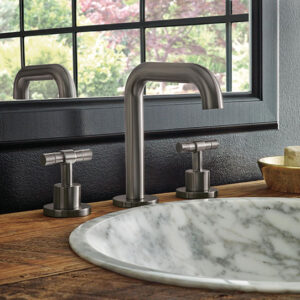In high-traffic commercial washrooms today, selecting the right touchless fixtures is not only a matter of style — it’s an intelligent investment in sanitation, productivity, and long-term cost savings. Touchless Fixtures: A Guidebook takes you step by step through all you need to know to find long-lasting, dependable, and easy-to-use touchless fixtures for high-traffic environments such as airports, malls, and public restrooms.
Why Touchless is Important in High-Traffic Washrooms
Hygiene and Health
Touchless fittings reduce physical contact, substantially lowering germ transfer on handles and buttons. Sensor-activated faucets and dispensers reduce surface contamination by reducing high-touch areas, as per Total Restroom’s guide to touchless restroom fixtures.
Consumer research quoted by Geberit North America indicates that more than 70% of users find restrooms cleaner when provided with automated fittings — a key element of public expectation and trust.
Efficiency and Waste Reduction
Touchless faucets and soap dispensers control the volume of water or soap released automatically, conserving waste and energy expenses. Sloan’s touchless technology shows how newer sensors save resources without sacrificing comfort and consistency in high-traffic environments.
Durability and Maintenance
Faucets in large public environments have to be strong enough to endure repeated use and indiscriminate abuse. As highlighted by Commercial Touchless Faucets’ vandal-resistant fixture guide, sensor products are less prone to exhaustion since there are no mechanical handles or mobile parts subject to exhaustion.
Key Features to Note
Power Supply and Reliability
Decide whether your fixtures are to be hard-wired or battery-operated. In heavily utilized buildings, reliability is uppermost. The ideal designs have long battery life or backup power sources to guarantee uninterrupted service, advises Watersino’s hygiene specialists.
Flow Rate and Water Savings
Efficiency is paramount. Install low-flow (usually 1.3–1.5 L/min) faucets to save water without reduced performance. Watersino points out that with such needs, there is substantial saving in long-term operating expenses.
Material and Vandal Resistance
Fixtures in public facilities have a longer lifespan made of solid brass, stainless steel, or impact-resistant polymer. Commercial Touchless Faucets suggests tamper-proof fasteners and hidden mounting to avoid abuse or theft.
Sensor Accuracy and Range
Effective infrared sensors must also operate under low-light or wet users’ hands. Range adjustment is also employed to avoid triggering unnecessarily — a necessity in high-occupancy usage environments.
Certifications and Compliance
Comply with commercial standards like WaterSense, LEED, and ADA accessibility. Sloan’s touch-free design guide observes that certified products not only conserve water but also allow for environmentally friendly design objectives.
Maintenance Accessibility
Regardless of how well they are made, all fixtures need periodic service. Choose models with easy cartridge replacement, exposed battery compartments, and modular designs. According to Commercial Touchless Faucets, facility managers should consider the accessibility feature as the second most important one after the tamper resistance feature.
Design and User Experience Considerations
Layout and User Flow
An uncluttered flow guarantees that there will be no overcrowding in a crowded restroom. The drying and sink area should be set in such a way that the best flow is achieved. It is easy for the users to pass through the zoned area with the help of spacious installations.
Finish and Aesthetics
Fixtures are highly important to establishing an up-to-date, professional bathroom environment. A-Town CPM’s article on Touchless Plumbing Benefits states matte black or brushed nickel finishes may contribute to design quality while withstanding fingerprints and corrosion.
Accessibility and Inclusivity
Universal needs of access also apply to touchless systems. Sloan suggests checking that controls and sensors are mounted at ADA-sanctioned height and that all fixtures are accessible to users of any capability.
Durability for Heavy Use
Select fixtures that are “institutional-grade” or “heavy-duty.” Stern Faucets’ commercial bathroom guide details models designed for airports, schools, and entertainment complexes that are used thousands of times daily.
Budget and Lifecycle Cost
Though the upfront cost is greater with touchless technology, ROI is high in the long run:
- Less water and soap usage translate into smaller utility bills (Total Restroom).
- Fewer components mean reduced maintenance and therefore a lower number of replacements (Commercial Touchless Faucets).
The increased user convenience is the basis of strong brand reputation in hospitality, healthcare, and retail sectors.
When planning your budgets, take into account installation, accessibility for maintenance, spare parts, and warranty coverage. Watersino recommends purchasing models with a 5–7-year commercial use warranty.
Step-by-Step Selection Process
Step 1: Define the Environment
Identify daily user numbers, type of facility, and risk of vandalism. The corporate restroom is not the same as an airport or sports arena.
Step 2: Define Required Fixtures
Imagine a full touchless system: automatic faucets, flush valves, soap dispensers, hand dryers, and open-top waste receptacles. Dudley Industries suggests open-top containers as a precaution against another frequent touchpoint.
Step 3: Set Up Performance Standards
For each fixture, the requirements for response time, flow rate, tamper resistance, and energy efficiency should be established. Geberit North America offers in-depth checklists for balancing hygiene and sustainability.
Step 4: Check Supplier and Warranty
Partnership with strong commercial-grade brands with good support and ready availability of spares. The buyer’s guide from Commercial Touchless Faucets provides a list of the main manufacturers that can be found in the market for heavy use.
Step 5: Installation and Servicing Planning
Correct installation of the wiring, battery in the proper place, and sensor in the proper place avoids false triggering. The distance between the sinks and dryers not only allows for a clear area but also for usability and cleanliness.
Step 6: Monitoring and Maintenance
Advanced touchless systems can feature usage tracking or remote maintenance notification. Add scheduled maintenance to extend lifespan and avoid downtime.
Conclusion
Choosing touchless fixtures for busy commercial washrooms is a matter of compromise between hygiene, durability, and user comfort against power efficiency and cost. Prioritizing first the confident power supplies, long-lasting materials, precise sensors, and accredited sustainability standards ensures that buildings provide a more premium washroom experience with the lowest long-term operating expense.
Touchless technology isn’t simply an upgrade in hygiene — it’s an investment in the safety, reputation, and overall efficiency of your facility.

No responses yet